This view of the Owner's Manual contains the very latest information, which may vary slightly from the printed Owner's Manual originally provided with your vehicle. It may also describe content that is not on or operates differently on your vehicle. Please consider the Owner's Manual originally provided with your vehicle as the primary source of information for your vehicle.

The information contained in this publication was correct at the time of release.In the interest of continuous development, we reserve the right to change specifications, design or equipment at any time without notice or obligation.No part of this publication may be reproduced, transmitted, stored in a retrieval system or translated into any language in any form by any means without our written permission.Errors and omissions excepted.
Copyright © 2024 Ford Motor Company
Changing a Road Wheel
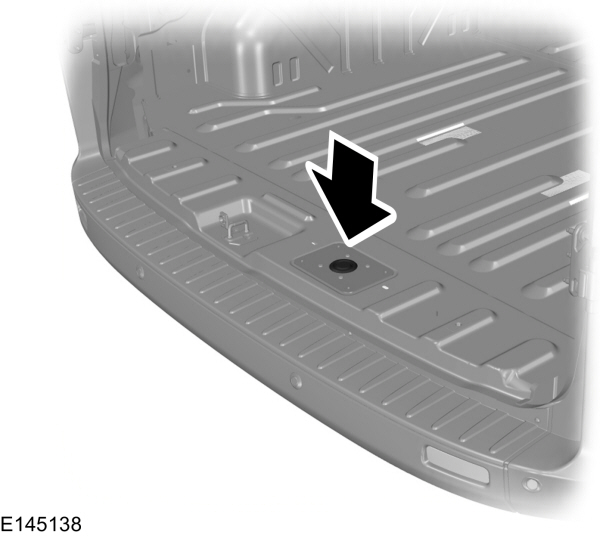
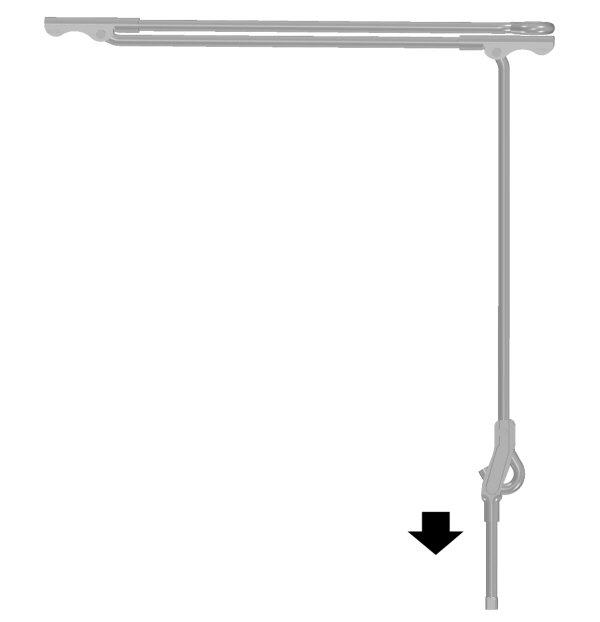
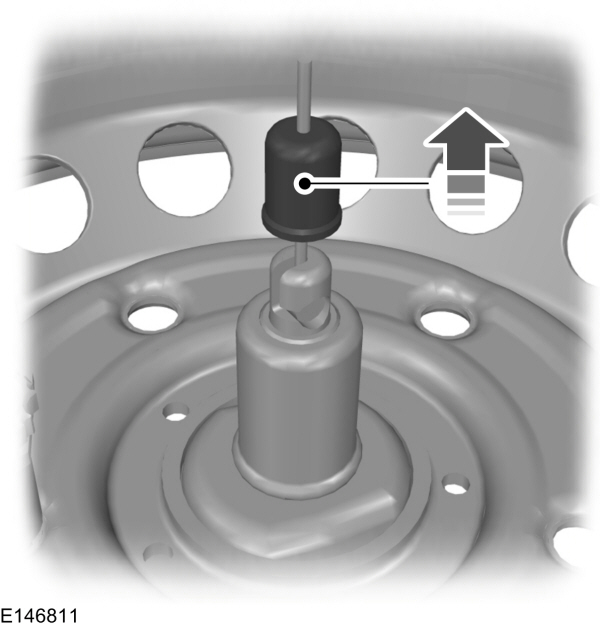
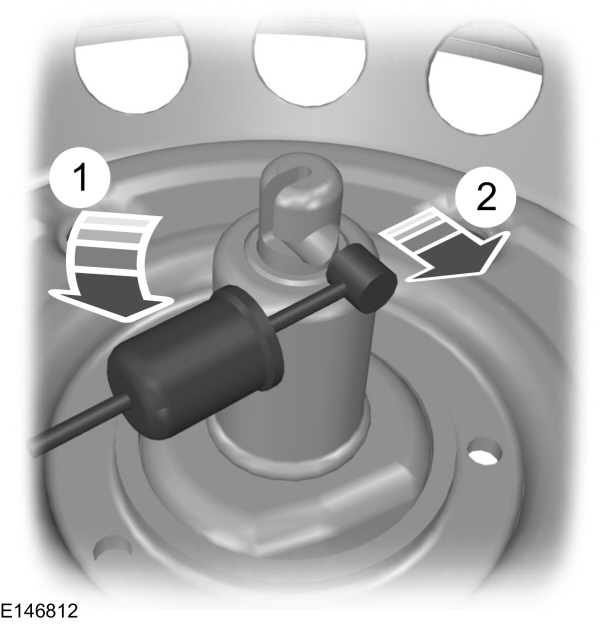





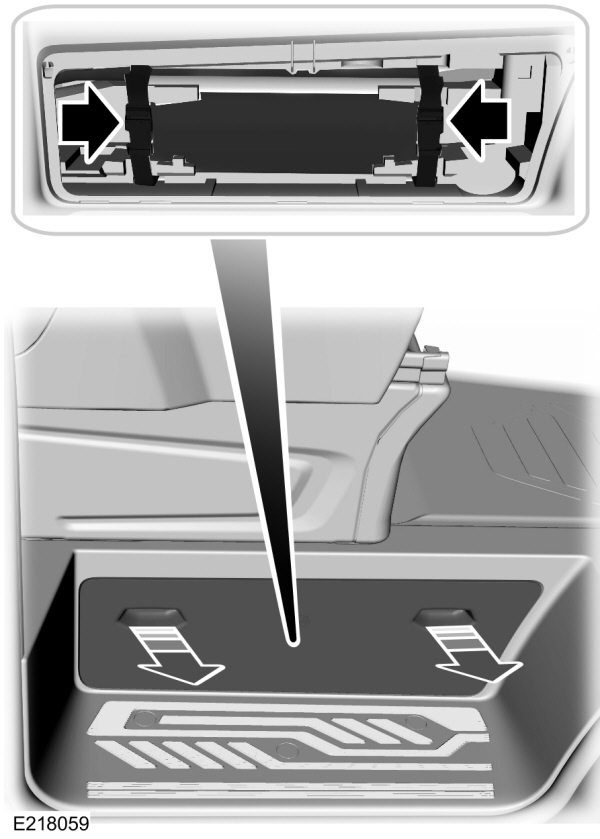
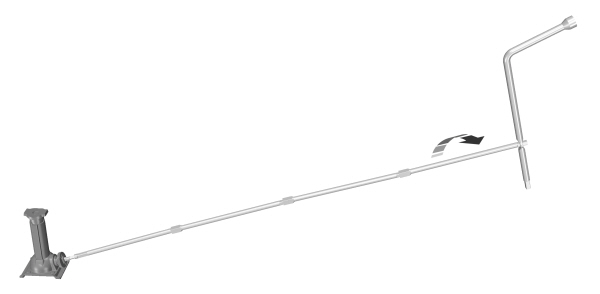







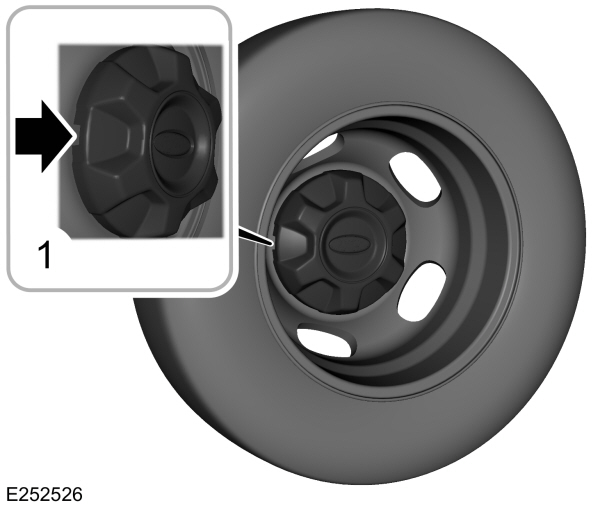


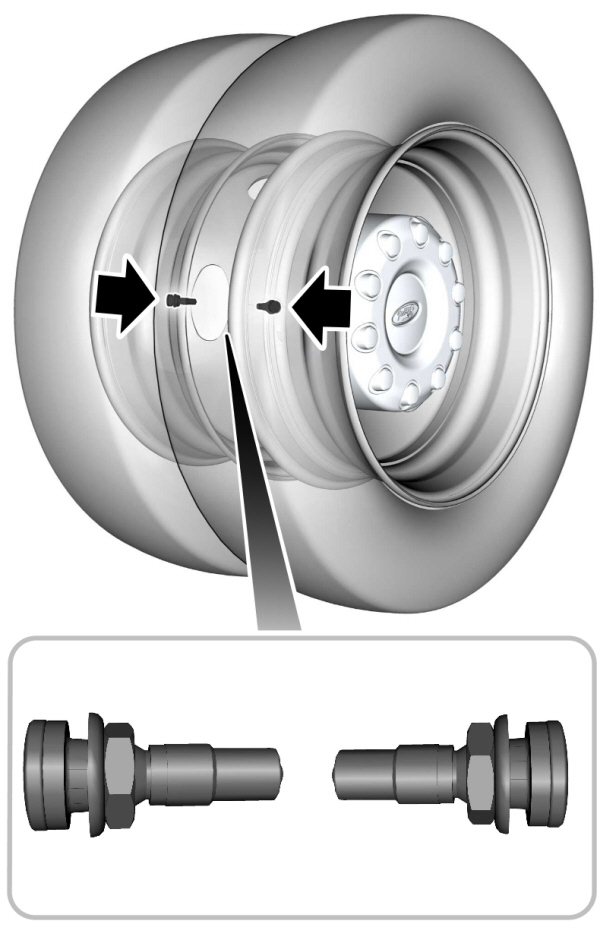

 WARNING:
If the tire pressure monitor sensor becomes damaged it may not function.
WARNING:
If the tire pressure monitor sensor becomes damaged it may not function. |
Note:
: The use of tire sealants can damage the tire pressure monitoring system.
Note:
The tire pressure monitoring system indicator light will illuminate when the spare tire is in use. To restore the full function of the monitoring system, all road wheels equipped with tire pressure monitoring sensors must be mounted on this vehicle.
If you get a flat tire while driving, do not apply the brake heavily. Instead, gradually decrease your speed. Hold the steering wheel firmly and slowly move to a safe place on the side of the road.
Have a flat serviced by an authorized dealer in order to prevent damage to the system sensors See
Tire Pressure Monitoring System.
Replace the spare tire with a road tire as soon as possible. During repairing or replacing of the flat tire, have the authorized dealer inspect the system sensor for damage.
Dissimilar Spare Wheel and Tire Assembly Information
 WARNING:
Failure to follow these guidelines could result in an increased risk of loss of vehicle control, injury or death.
WARNING:
Failure to follow these guidelines could result in an increased risk of loss of vehicle control, injury or death. |
If you have a dissimilar spare wheel and tire, then it is intended for temporary use only. This means that if you need to use it, you should replace it as soon as possible with a road wheel and tire assembly that is the same size and type as the road tires and wheels that were originally provided by Ford. If the dissimilar spare tire or wheel is damaged, it should be replaced rather than repaired.
A dissimilar spare wheel and tire assembly is defined as a spare wheel and tire assembly that is different in brand, size or appearance from the road tires and wheels and can be one of three types:
1. T-type mini-spare: This spare tire begins with the letter T for tire size and may have Temporary Use Only molded in the sidewall.
2. Full-size dissimilar spare with label on wheel: This spare tire has a label on the wheel that states: THIS WHEEL AND TIRE ASSEMBLY FOR TEMPORARY USE ONLY.
When driving with one of the dissimilar spare tires listed above, do not:
- Exceed 50 mph (80 km/h).
- Load the vehicle beyond maximum vehicle load rating listed on the Safety Compliance Label.
- Tow a trailer.
- Use snow chains on the end of the vehicle with the dissimilar spare tire.
- Use more than one dissimilar spare tire at a time.
- Use commercial car washing equipment.
- Try to repair the dissimilar spare tire.
- Handling, stability and braking performance.
- Comfort and noise.
- Ground clearance and parking at curbs.
- Winter weather driving capability.
- Wet weather driving capability.
- All-wheel driving capability.
3. Full-size dissimilar spare without label on wheel
When driving with the full-size dissimilar spare wheel and tire assembly, do not: - Exceed 70 mph (113 km/h).
- Use more than one dissimilar spare wheel and tire assembly at a time.
- Use commercial car washing equipment.
- Use snow chains on the end of the vehicle with the dissimilar spare wheel and tire assembly.
- Handling, stability and braking performance.
- Comfort and noise.
- Ground clearance and parking at curbs.
- Winter weather driving capability.
- Wet weather driving capability.
- All-wheel driving capability.
- Towing a trailer.
- Driving vehicles equipped with a camper body.
- Driving vehicles with a load on the cargo rack.
Drive cautiously when using a full-size dissimilar spare wheel and tire assembly and seek service as soon as possible.
Locking Lug Nuts (If Equipped)
You can obtain replacement locking lug nuts or a locking lug nut key using the reference number certificate.
The locking lug nut key is located in the glove box or in the storage compartment in the front right-hand side stepwell.
Vehicles With a Spare Wheel
The spare wheel is under the rear of your vehicle.
If the spare wheel is the same type and size as your vehicle road wheel, you can fit the spare wheel and continue to drive in the normal manner.
If the spare wheel is not the same type and size as your vehicle road wheel, it has a label showing the maximum driving speed limit.
Note:
If your vehicle is fitted with a tire pressure monitoring system, the warning indicator will flash if you fit the spare wheel to your vehicle. To restore the correct operation of the tire pressure monitoring system, you must have the repaired road wheel and tire assembly refitted to your vehicle. See
Tire Pressure Monitoring System.
To prevent damage occurring to the tire pressure monitoring system sensors, make sure you have a damage tire repaired or replaced by a tire professional.
Van, Bus or Wagon

- Open the rear doors and remove the grommet.

- Insert the square end of the wheel brace or the short arm of the jack handle into the socket. Turn counterclockwise until the spare wheel rests on the ground and the cable is loose.

- Raise the cable end cover.

- Rotate the cable through 90 degrees. Slide the cable through the slot to release the spare wheel bracket from the winch.

- Remove the retaining nut to release the spare wheel bracket.
- Leave the cable extended; it will be used to stow the flat wheel and tire assembly.
Note:
Do not raise the spare wheel bracket without a wheel attached.Damage to the winch mechanism could occur.
Chassis Cab and Cutaway

- Insert the square end of the wheel brace or the short arm of the jack handle into the socket. Turn counterclockwise until the spare wheel rests on the ground and the cable is loose.

- Raise the cable end cover.

- Rotate the cable through 90 degrees. Slide the cable through the slot to release the spare wheel bracket from the winch.

- Remove the retaining nut to release the spare wheel bracket.
- Leave the cable extended; it will be used to stow the flat wheel and tire assembly.
Note:
Do not raise the spare wheel bracket without a wheel attached.Damage to the winch mechanism could occur.
Vehicle Jack
 WARNING:
Do not work on your vehicle when the jack is the only support as your vehicle could slip off the jack. Failure to follow this instruction could result in personal injury or death.
WARNING:
Do not work on your vehicle when the jack is the only support as your vehicle could slip off the jack. Failure to follow this instruction could result in personal injury or death. WARNING:
To help prevent your vehicle from moving when changing a wheel, shift the transmission into park (P), set the parking brake and use an appropriate block or wheel chock to secure the wheel diagonally opposite to the wheel being changed. For example, when changing the front left wheel, place an appropriate block or wheel chock on the right rear wheel.
WARNING:
To help prevent your vehicle from moving when changing a wheel, shift the transmission into park (P), set the parking brake and use an appropriate block or wheel chock to secure the wheel diagonally opposite to the wheel being changed. For example, when changing the front left wheel, place an appropriate block or wheel chock on the right rear wheel. WARNING:
Do not attempt to change a tire on the side of the vehicle close to moving traffic. Pull far enough off the road to avoid the danger of being hit when operating the jack or changing the wheel.
WARNING:
Do not attempt to change a tire on the side of the vehicle close to moving traffic. Pull far enough off the road to avoid the danger of being hit when operating the jack or changing the wheel. WARNING:
Always use the jack provided as original equipment with your vehicle. If using a jack other than the one provided, make sure the jack capacity is adequate for the vehicle weight, including any vehicle cargo or modifications. If you are unsure if the jack capacity is adequate, contact the authorized dealer.
WARNING:
Always use the jack provided as original equipment with your vehicle. If using a jack other than the one provided, make sure the jack capacity is adequate for the vehicle weight, including any vehicle cargo or modifications. If you are unsure if the jack capacity is adequate, contact the authorized dealer. WARNING:
Switch off the running boards before jacking or placing any object under your vehicle. Never place your hand between the extended running board and your vehicle. A moving running board may cause injury.
WARNING:
Switch off the running boards before jacking or placing any object under your vehicle. Never place your hand between the extended running board and your vehicle. A moving running board may cause injury. |
Note:
Passengers should not remain in the vehicle when the vehicle is being jacked.
Note:
Vehicles with a Temporary Mobility Kit do not have a vehicle jack or a lug wrench.
Vehicle Jack Storage

The jack, jack handle and wheel brace are in a storage compartment in the front right-hand side stepwell.
Note:
The vehicle jack is in the load space area on vehicles with rear climate control.

- Assemble the jack handle.
- Insert the jack handle into the jack.
- Insert the end of the jack handle into the wheel brace and rotate clockwise to raise your vehicle.
Front Jacking Points
 WARNING:
You must use the specified jacking points.
WARNING:
You must use the specified jacking points. |
Note:
If your vehicle has rear air conditioning make sure the vehicle jack does not come in contact with the air conditioning lines.

Position the head of the vehicle jack under the protrusions at the rear of front sub-frame.
Rear Jacking Points
 WARNING:
You must use the specified jacking points.
WARNING:
You must use the specified jacking points. |

Position the head of the vehicle jack under the rear axle.
Removing a Wheel Trim (If Equipped)
Vehicles With Steel Wheels
- Insert the flat end of the lug wrench between the wheel rim and the wheel trim.
- Carefully remove the wheel trim.
Vehicles With Dual Rear Alloy Wheels



The wheel trim removal tool is in the storage compartment in the front right-hand side stepwell near the lug wrench.
Front Wheel Trim

- Locate the notch in the wheel trim.

- Insert the wheel trim removal tool into the notch in the wheel trim.
- Rotate the wheel trim removal tool and remove the wheel trim.
Rear Wheel Trim

- Locate the notch in the wheel trim.

- Insert the wheel trim removal tool into the notch in the wheel trim.
- Rotate the wheel trim removal tool and remove the wheel trim.
Removing a Road Wheel
 WARNING:
Park your vehicle so that you do not obstruct the flow of traffic or place yourself in any danger and set up a warning triangle.
WARNING:
Park your vehicle so that you do not obstruct the flow of traffic or place yourself in any danger and set up a warning triangle. WARNING:
Switch the ignition off and apply the parking brake.
WARNING:
Switch the ignition off and apply the parking brake. WARNING:
If your vehicle has a manual transmission, shift into first or reverse gear. If your vehicle has an automatic transmission, shift into park (P).
WARNING:
If your vehicle has a manual transmission, shift into first or reverse gear. If your vehicle has an automatic transmission, shift into park (P). WARNING:
Make sure all passengers are out of your vehicle.
WARNING:
Make sure all passengers are out of your vehicle. WARNING:
Make sure that your vehicle is on firm and level ground with the front wheels pointing straight ahead.
WARNING:
Make sure that your vehicle is on firm and level ground with the front wheels pointing straight ahead. WARNING:
Chock the diagonally opposite wheel to the punctured tire with an appropriate block or wheel chock. A wheel chock may be in the B-pillar or in a storage compartment in the front right-hand side stepwell.
WARNING:
Chock the diagonally opposite wheel to the punctured tire with an appropriate block or wheel chock. A wheel chock may be in the B-pillar or in a storage compartment in the front right-hand side stepwell. WARNING:
Make sure that the arrows on directional tires point in the direction of rotation when your vehicle is moving forward. If you have to fit a spare tire with the arrows pointing in the opposite direction have the tire refitted as soon as possible.
WARNING:
Make sure that the arrows on directional tires point in the direction of rotation when your vehicle is moving forward. If you have to fit a spare tire with the arrows pointing in the opposite direction have the tire refitted as soon as possible. |
- Use the locking lug nut key to loosen the locking lug nut.
- Loosen the remaining lug nuts, but do not remove them.
- Raise your vehicle until the tire is clear of the ground.
- Remove the lug nuts and the road wheel.
Note:
Do not lay alloy road wheels face down on the ground.
Installing a Road Wheel
 WARNING:
Use only approved wheel and tire sizes. Using other sizes could damage your vehicle and will make the National Type Approval invalid.
WARNING:
Use only approved wheel and tire sizes. Using other sizes could damage your vehicle and will make the National Type Approval invalid. WARNING:
Make sure there is no grease or oil on the threads or the surface between the wheel lugs and nuts. This can cause the lug nuts to loosen while driving.
WARNING:
Make sure there is no grease or oil on the threads or the surface between the wheel lugs and nuts. This can cause the lug nuts to loosen while driving. WARNING:
When you install a wheel, always remove any corrosion, dirt or foreign materials present on the mounting surfaces of the wheel or the surface of the wheel hub, brake drum or brake disc that contacts the wheel. Make sure to secure any fasteners that attach the rotor to the hub so they do not interfere with the mounting surfaces of the wheel. Installing wheels without correct metal-to-metal contact at the wheel mounting surfaces can cause the wheel nuts to loosen and the wheel to come off while your vehicle is in motion, resulting in loss of vehicle control, personal injury or death.
WARNING:
When you install a wheel, always remove any corrosion, dirt or foreign materials present on the mounting surfaces of the wheel or the surface of the wheel hub, brake drum or brake disc that contacts the wheel. Make sure to secure any fasteners that attach the rotor to the hub so they do not interfere with the mounting surfaces of the wheel. Installing wheels without correct metal-to-metal contact at the wheel mounting surfaces can cause the wheel nuts to loosen and the wheel to come off while your vehicle is in motion, resulting in loss of vehicle control, personal injury or death. WARNING:
Only use the specific lug nuts and wheels supplied with your vehicle. If in doubt, contact an authorized dealer.
WARNING:
Only use the specific lug nuts and wheels supplied with your vehicle. If in doubt, contact an authorized dealer. WARNING:
Do not install alloy wheels using lug nuts designed for use with steel wheels.
WARNING:
Do not install alloy wheels using lug nuts designed for use with steel wheels. WARNING:
The lug nuts of alloy wheels and spoked steel wheels can also be used for the steel spare wheel for a short time (maximum two weeks).
WARNING:
The lug nuts of alloy wheels and spoked steel wheels can also be used for the steel spare wheel for a short time (maximum two weeks). |
- Install the wheel.

- Install all of the lug nuts and partially tighten them in the sequence shown.
- Lower your vehicle and remove the vehicle jack.
- Fully tighten all of the lug nuts in the sequence shown.
- Install the wheel trim.
Note:
Make sure that the lug nuts are fully seated against the wheel.
Note:
Alloy wheel lug nuts are suitable for use on a steel spare wheel.
Note:
If the spare wheel is not the same type and size as your vehicle road wheel replace it as soon as possible.
Note:
Check the lug nuts for correct tightness and check the tire pressure as soon as possible.

Note:
When installing dual rear wheels, align the valve stems facing each other.
Stowing the Wheel and Vehicle Jack
Note:
Do not raise the spare wheel bracket without a wheel attached.If you lower the spare wheel bracket without a wheel attached, you may damage the winch mechanism.
- Attach the spare wheel bracket to the wheel using the retaining nut.
- Slide the cable through the slot and attach the spare wheel bracket to the winch.
- Rotate the cable through 90 degrees and lower the cable end cover.

- Insert the flat end of the lug wrench into the socket.Turn it clockwise until you feel a strong resistance.
Note:
Make sure the spare wheel is secure by tightening the winch until you feel a slip.
- Stow the vehicle jack, jack handle and lug wrench in their correct locations and secure them with the straps.
Thank You For Your Feedback
